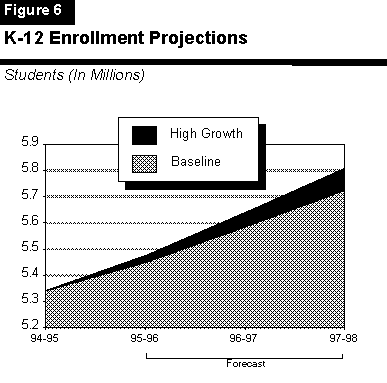

This section reviews our estimates of state education costs, including Proposition 98 (K-12 schools and community colleges) and other state higher education agencies.
The Spending Forecast. We estimate that annual growth in Proposition 98 General Fund spending for K-14 education will be in the range of 9 percent to 10 percent annually in 1996-97 and 1997-98, reaching $20.3 billion in 1997-98. This is $3.3 billion more than our revised 1995-96 estimate. This assumes the state provides the minimum level of funding required under Proposition 98 each year. We revised our estimate of the 1995-96 Proposition 98 guarantee by adding $750 million to the amount assumed in the Budget Act due to stronger than anticipated growth in state revenues and K-12 enrollment.
Key Forecast Factors. General Fund expenditures for Proposition 98 depend on the following factors: the state's personal income, General Fund tax revenues, local property tax revenues, and K-12 enrollment. Our economic forecast assumes that per capita personal income and state tax revenues will grow at about 4 percent and 6 percent, respectively, each year. We also assume that local property tax revenues will recover from the historic low rate of growth observed for 1994-95, reaching a growth rate of about 5 percent by 1997-98.
The key education factor is the growth in K-12 enrollment. Based on fall 1995 K-12 enrollment figures, our projection of Proposition 98 spending assumes that 1995-96 enrollment will increase about 2 percent, higher than the 1.5 percent pace assumed in the Budget Act. We project enrollment growth will accelerate to 2.5 percent for 1996-97 and 1997-98. This is shown in Figure 6 as our baseline enrollment projection.

Enrollment growth could be even higher, however. In 1993-94 and 1994-95, K-12 enrollment growth fell below expectations. This is most likely because more people left California than moved into the state during the early 1990s. Given improvements in the state's economy relative to the rest of the country, it is possible that in-migration will increase and enrollment growth will return to its previous pattern.
If this occurs, K-12 enrollment growth rates--and Proposition 98 spending--could be higher than we have assumed. Figure 7 displays the additional Proposition 98 spending that would result from somewhat higher K-12 enrollment growth rates (2.5 percent in 1995-96 and 3 percent in 1996-97 and 1997-98). This rapid growth scenario would require $130 million more Proposition 98 (and General Fund) spending than we have projected in 1995-96, increasing to about $450 million more in 1997-98.
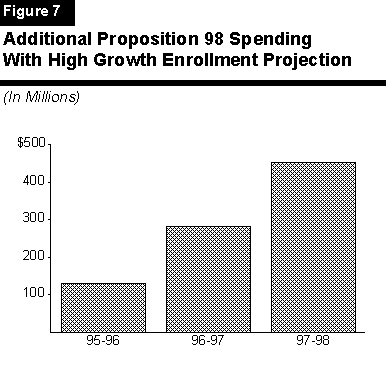
K-12 Funding Projections. Figure 8 displays our projected K-12 per-pupil funding levels from 1995-96 through 1997-98. These estimates, which are derived from our baseline Proposition 98 forecasts, reflect annual per-pupil increases of about 5 percent over the three-year period.
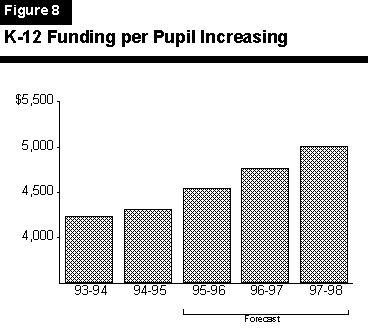
Community College Funding Projections. Based on our Proposition 98 projections, we estimate total community college funding will increase by about 6 percent each year over the three-year period.
In addition to community colleges, the state's public higher education systems include the University of California (UC) and the California State University (CSU). The UC consists of eight general campuses, one health science campus, and numerous special research facilities. The UC awards bachelor's, master's, and doctoral degrees, as well as various professional degrees. The UC has primary jurisdiction over research. The CSU consists of 22 campuses and several off-campus centers. The CSU grants bachelor's and master's degrees and may award doctoral degrees jointly with the UC or a private university.
The Spending Forecast. We estimate that spending for UC and CSU (excluding funding for debt service) will increase from $3.4 billion in 1995-96 to over $3.5 billion in 1996-97, or by roughly 4 percent (the percentage increases at each segment are similar). For 1997-98, we estimate that spending for UC and CSU (excluding funding for debt service) will increase to almost $3.7 billion or by about 4 percent compared to 1996-97.
Key Forecast Factors. Three main factors account for state expenditure growth in higher education: salary increases, enrollment growth, and increases in fees and tuition. Our assumptions in these areas are as follows:
The major state judiciary and criminal justice programs include support for four agencies in the executive branch--the Departments of Corrections, the Youth Authority, Justice, and the Office of Criminal Justice Planning--as well as expenditures for local trial courts and state appellate courts. The largest expenditure programs--the Department of Corrections and the Trial Court Funding Program--are discussed in more detail below.
The Spending Forecast. The department's General Fund support budget is forecast to grow more than 30 percent between 1994-95 and 1997-98, exceeding $3.6 billion annually at the end of that period. Anticipated receipt of $260 million annually in federal funds would partially offset these state General Fund costs.
The projected rapid growth in adult correctional expenditures continues a trend of steadily larger CDC budgets that has existed since the early 1980s. Between 1980-81 and 1994-95, General Fund support for the CDC grew more than 640 percent.
Key Forecast Factors. The significant increases projected in General Fund support for the CDC reflect major growth in the prison inmate population expected during the forecast period. Figure 9 shows that the CDC anticipates that the prison population, which is now about 134,000, will exceed 179,700 by June 1998. By June 2005, the CDC expects to house nearly 306,000 prison inmates.
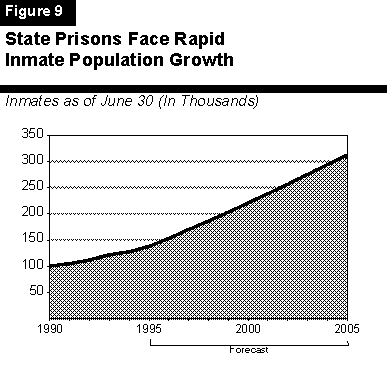
The jump in prison population is largely the result of tougher sentencing measures approved by the Legislature, Governor, and the voters, including the "Three Strikes and You're Out" law enacted last year. Demographic shifts, local government support for law enforcement activities, and other factors are also contributing to the prison population boom.
Meanwhile, the number of parolees under the supervision of CDC parole agents is also expected to grow, although more slowly than the number of prison inmates. Because many offenders are serving longer prison terms, fewer are now being released on parole than would otherwise have occurred.
The state now supervises about 93,000 parolees, and the number is projected to be 97,600 by June 1998. By June 2005, the count of CDC-supervised parolees is projected to exceed 136,400.
The Spending Forecast. The total trial court budget forecast grows to $1.9 billion in 1997-98 from $1.7 billion in 1994-95. Currently, the state funds approximately 37 percent of the trial court costs. Assuming continuation of this funding share, the state's General Fund costs are estimated to be $526 million. This is an increase of 9 percent between 1994-95 and 1997-98, or an average annual growth rate of 2.9 percent.
Key Forecast Factors. The projected growth is due primarily to anticipated caseload increases in the trial courts, particularly criminal caseloads resulting from enhanced sentencing measures approved by the Governor, the Legislature, and the voters such as the "Three Strikes and You're Out" law. Cost increases due to caseload growth are mitigated somewhat by refinements in the budgeting process by the Judicial Council that help to better estimate trial court costs, as well as efficiencies implemented in some superior and municipal courts, such as court coordination efforts.
The remainder of the budget involves such program areas as debt service, tax relief (including the renters' credit and homeowners' exemption), retirement contributions, regional developmental centers, state mental hospitals, and various other smaller programs. We project these program areas will cost approximately $11.1 billion in 1995-96, $11.8 billion in 1996-97, and $12.5 billion by 1997-98.
Figure 10 also shows that debt service for lease-payment bonds is becoming a greater portion of the state's total debt-service costs. For example, lease-payment debt service was 15 percent of total debt service in 1995-96, and will increase to 19 percent in 1997-98.
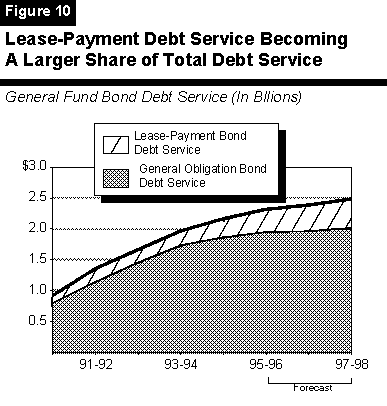
The renters' tax credit was suspended for three years--1993, 1994, and 1995. The program is scheduled to be reinstated January 1, 1996 and will result in an estimated cost of $517 million in 1996-97 and $525 million in 1997-98.